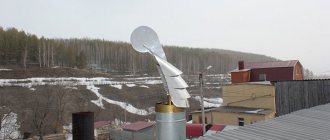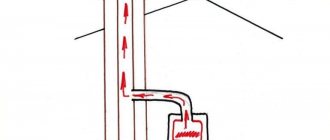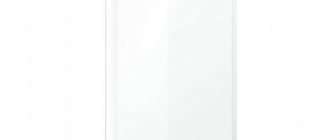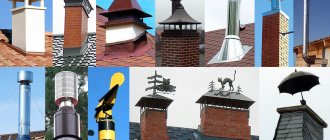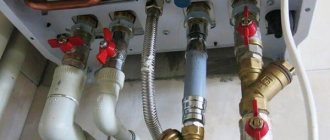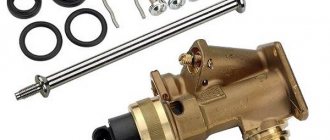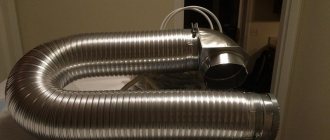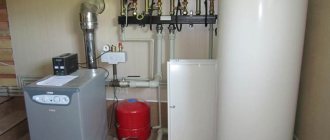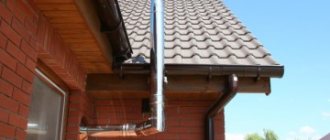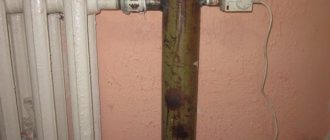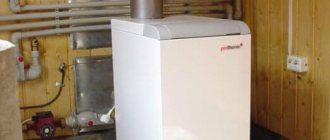The need to install a chimney deflector
The functioning of heating equipment is reflected in how air circulates in the system and smoke is eliminated. If these mechanisms are not debugged, then the fuel combustion process is disrupted, carbon monoxide enters the room and causes serious damage to health.
Each part of the chimney must be installed correctly, otherwise the draft will be poor
It happens that the correct parameters of the chimney, that is, cross-section, height and configuration, are not able to normalize the operation of a stove or fireplace. In such a situation, they resort to a deflector installed on the upper section of the chimney.
According to the rules, the smoke exhaust channel must be vertical and fairly straight. The recommended height of the pipe above the level of the roof ridge is less than 50 cm.
The deflector has an important mission - to equalize or increase draft in heating equipment. The device’s assistant in this matter is the wind, which creates a space with rarefied air and pushes combustion products into it that could not escape from the smoke duct.
The deflector often saves the situation if traction cannot be improved by any other means.
The deflector is also assigned some other tasks that help improve the operation of the chimney as a whole. The device blocks the access of rainwater and snow to heating equipment. Thanks to the deflector, the stove operates without interruption even on a stormy day.
Chimney deflector design
In the standard version, the chimney consists of three main elements:
- Cylinder
- Diffuser
- Umbrella (protective cap)
In addition to the deflector, there are annular fenders - they are located around and at the bottom of the product. Chimneys come in a wide variety of sizes, shapes and designs, since, in addition to their main functions, they also perform decorative ones. Regardless of the composition, these products work on the same principle.
Namely. The diffuser of the device affects the change in the speed of smoke movement in the chimney, the umbrella acts as a protection for the chimney from precipitation and debris, and the body of the product is responsible for dispersing the air and creating a vacuum zone, which enhances draft.
The principle of operation of the weather vane
The functioning of a deflector or weather vane is the following process:
- when the wind blows into the pipe from top to bottom, the products of fuel combustion are drawn out by the lower annular hole of the device;
- if air flows act from bottom to top, then the gases are filtered out by the upper annular slot;
- When the wind blows in a horizontal direction, carbon monoxide and other unnecessary substances are sucked out by two holes at once.
A weather vane works worst when the wind is blowing upward. This is due to the fact that the umbrella repels air flows and directs them in the direction opposite to the movement of combustion products.
The device forces the wind to travel in a certain direction, which improves traction
In order for the deflector to work without failure, regardless of the direction of the wind, the umbrella of the device is shaped into two cones connected by the bases. The lower cone has a specific role - to repel the flow of air and combustion products, pushing them apart and directing them towards the outlet of the pipe.
Manufacturing of deflectors
A chimney deflector is a device consisting of three main parts: a lower cylinder, an upper glass (diffuser) and a cone-shaped cap (umbrella).
The lower cylinder is made from a pipe, the material for which can be asbestos, metal or ceramics. An upper glass is attached to this element, fixed on three or four posts and increasing towards the bottom. A cone-shaped cap, sometimes called an umbrella, is installed above it.
In the upper section of both the lower and upper glasses, annular rebounds are created. They prevent the wind from taking a vertical direction.
The deflector consists of: 1 - umbrella-cap, 2 - legs, 3 - conical shield, 4 - diffuser, 5 - pipe, 6 - body
The weather vane is installed in a special way so that the wind blowing in any direction does not create barriers to the removal of gases. Air flows should facilitate the release of combustion products attracted by the upper and lower rings.
Diffuser and umbrella are products most often made of zinc coated steel. The best raw material for creating these deflector parts is high-quality boiler steel, because they operate in conditions of variable humidity, unexpected temperature changes and a high risk of rust formation.
According to their design, weather vanes are divided into types:
- Grigorovich deflector;
- weather vane deflector;
- H-shaped deflector;
- TsAGI deflector;
- spark arrestor
Why are deflectors needed?
Every person may wonder: what are deflectors for? You can answer this question by familiarizing yourself with the design and main functions that this device performs. The main feature of the chimney, due to which smoke is removed from the system, is draft. Creating the necessary draft through a pressure difference contributes to the complete removal of combustion products outside the house. In order for the draft to be sufficient, the following parameters are calculated: the diameter of the pipes in the structure, the type of their cross-section, the material of manufacture, the height of the pipe above the roof, etc. The general shape of the structure is also an important factor.
In strong winds, air can enter the pipe lumen, thereby creating an obstacle to the normal removal of smoke from the system. In some cases, this can lead to the formation of backdraft and smoke in the heated room. The deflector not only protects the chimney from wind, but also uses its force to increase draft.
Types of deflectors
Device typeCharacteristics
| TsAGI deflector | The most common option. It has a cylindrical shape and is made of stainless steel or galvanized steel. Connection type – nipple, flange |
| Round Volper | The design is similar to the TsAGI deflector, but has slight differences in the upper part. Made of galvanized steel, stainless steel and copper, most often used for chimneys in bathhouses |
| Grigorovich deflector | An improved version of TsAGI, designed for areas with prevailing low winds. Provides good traction even in calm weather |
| Disc Astato | Very efficient and simple open design. Provides high-quality traction regardless of wind direction. Made from galvanized and stainless steel |
| H-shaped | Reliable design, effective in any wind direction. Made of stainless steel, the connection is made using a cut-in on the device pipe |
| Deflector-vane | A device with a rotating body and a weather vane attached to the top. Made from stainless steel or painted carbon steel |
| Rotating deflector | The device rotates only in one direction, effectively protects the chimney from clogging and precipitation, and is excellent for gas boilers. Does not work in calm conditions or when icing |
The main differences are in the shape of the structure and the number of components. The material for the manufacture of such devices is stainless and galvanized steel, less often copper. They are cylindrical, square, round, open and closed in shape. Devices of the same type may differ in the upper part: some products are made with a cone-shaped umbrella, others have a gable or hip roof, others are made flat or with decorative figured elements.
Deflectors
The diameter of the deflector varies from 100-500 mm, the width of the diffuser from 240 to 1000 mm, the height of the structure - from 14 to 60 cm.
Deflector sizes
The device is attached to the chimney using brackets, clamps, bolts, and sealing tape. For manufacturing, steel with a thickness of 0.5 to 1 mm is used, depending on the diameter of the deflector itself. Additionally, the device can be equipped with a spark arrester if there is a risk of roof fire.
Deflectors with spark arrestors
Types of chimneys
There are many different types of deflectors, which vary in shape and appearance. We list the main types:
- TsAGI
- Grigorovich
- round Volper
- H-shaped
- disc-shaped
- rotating
- vane
TsAGI deflector
The abbreviation TsAGI stands for “Central Aerohydrodynamic Institute”. The design of the TsAGI chimney was developed by this institute, which is why it bears its name. This chimney is considered universal; it consists of a diffuser, an umbrella, a ring and a pipe, which is fixed on the chimney. The convenient location of the umbrella in this type of chimney is considered their main advantage. This type of product increases draft, protects the smoke removal and ventilation system. The TsAGI design cuts air flows well, facilitating the rapid removal of combustion products from the chimney. An umbrella is located in the inner part of the cylinder, which helps to achieve the best protection of the pipe from precipitation.
Dymnik Grigorovich
One of the most affordable and simple types - you can make it yourself, with your own hands. It has a simple design of an upper and lower cylinder, a regular cone and mounting brackets. Among the advantages of this type is the simplicity of design, assembly and installation, and the disadvantages are that the diffuser umbrella is too high, which can cause smoke to blow in on the sides. This type of device is not sufficient to increase the level of traction, but it protects well from precipitation and debris.
Round deflector Volper
A device similar to TsAGI, performing the same functions with the same efficiency. The difference lies in the visor, which is located above the diffuser - it protects the pipe from dirt and precipitation getting inside.
H-shaped deflector
The design of this type of chimney uses pipe sections, due to which it can withstand very high wind loads. The main parts of this chimney are mounted in the shape of the letter H, and the design includes a horizontal pipe. Thanks to this device, even the very possibility of dirt and precipitation entering the smoke duct is completely eliminated. At the same time, the vertical side parts of such a chimney increase the level of draft, at the same time removing smoke masses in different directions.
Vane
The design of this smoke hood consists of two visors, which are connected to each other to rotate in a circle. For constant movement of the weather vane, it has a small weather vane on top. Some products have small arrow pins that serve to determine the direction of the wind and cut the wind and air, which increases traction. Of course, the weather vane also prevents dirt and sediment from entering the smoke channel. Among the disadvantages of this type is the short service life of the bearing, which ensures movement.
Disc deflector
A very affordable and simple type of device that provides protection for the chimney and a very high level of draft in the chimney. Its design includes a special visor that prevents dirt and precipitation from entering the pipe. At the bottom of the structure there is a cap - it is directed towards the chimney. The air entering the weather vane turns into a rarefied narrow channel, which increases the draft several times.
Rotating weather vane
This deflector rotates due to air movement, and therefore remains motionless in calm conditions. At the same time, in conditions of ice it stops its work, to resume which it must be warmed up and cleaned. But the design of the device protects the chimney well from debris and precipitation. It is considered rational to use this weather vane together with powerful heat-generating devices, for example, gas boilers.
Questions about calculations
If you decide to make a deflector yourself, you cannot do without competent calculations and a sketch of the intended product. It is required to be based on the internal diameter of the chimney.
It is also necessary to know the dependence of the deflector parameters and this value.
To identify values, you need to multiply the base size:
- lower diameter (D) – by 2,
- top - by 1.5,
- heights of the cone and umbrella - by 0.25.
- for the pipe entrance to the diffuser - by 0.15
If you are planning a standard product, then the dimensions can be taken from this table (parameters in cm):
Internal pipe D Height of deflector (cm) D diffuser (cm) 12 14.4 24 14 16.8 28 20 24 40 40 48 80 50 60 100
Using this data, you don’t have to resort to calculations. But if you don’t find the required values, use a calculator.
When creating a deflector with your own hands and personal parameters, use the following formulas:
D diffuser = 1.2 x D inner pipe.
H = 1.6 x D int. pipes;
Cover width = 1.7 x D int. pipes.
Knowing all the parameters, you can calculate the sweep value of the umbrella cone. The Pythagorean theorem works:
R = √(D/2)² + H²
Next, the dimensions of the area that will be created from the workpiece are determined.
The length of the full circle should be taken into account. Assuming 360 degrees, it (L) is 2π R.
The length of the circle serving as the base of the created cone (Lm) is inferior to the value of L. Their difference serves as the basis for calculating the arc length of the X sector.
For this task, a proportion is formed:
L/360⁰ = Lm/X
On its basis, the required parameter is determined: X = 360 x Lm/ L. Then the result must be subtracted from 360. This is the answer in determining the size of the cut area.
If the deflector should reach 16.8 cm in height and 28 cm in diameter, then the workpiece has a radius of 21.9 cm, its Lm = 218.7 x 2 x 3.14 = 137.3 cm.
The circumference of the required cone is calculated as follows: 28 x 3.14 = 87.9 cm. This gives: 879/1373 x 360⁰ = 230⁰. Angle of cut area = 130 degrees (360 – 230).
If you need to build a truncated cone, you will only know the height of the truncated segment. But the calculation is made in the same way, according to the Pythagorean theorem.
The total height is calculated as follows:
(D – Dm)/ 2H = D/2Hp
From this it turns out that Hp = D x H / (D-Dm). Then the dimensions of the workpiece are determined for the entire cone. Its upper part is subtracted from the result.
If more data is known to create a truncated cone, for example H = 24 cm, lower D is 40 cm, and upper D is 30 cm.
The entire height (Hp) is 96 cm. This is the result of solving 40 x 24/ (40 – 30).
Outer radius (Rz) =98.6 cm. Obtained from the operation Rz = √(40/2)² + 96².
The radius of the smallest hole (Rm) reaches 23.9 cm. This is the result of the actions Rm = √(96 – 24)² + (30|2)²
The angle of the segment is 73.4 degrees. Calculation result 36/2 x 40/98.6
The radius of one arc is 98.6 cm, the second is 23.9 cm. Both are drawn from the same point at an angle of 73.4⁰.
If overlapping edges are required, add allowances.
size table
Channel diameter (internal), mm dDeflector height, mm N Diffuser width, mm D
| 120 | 145 | 241 |
| 140 | 167 | 280 |
| 200 | 241 | 400 |
| 400 | 481 | 800 |
| 500 | 600 | 1000 |
If you need to calculate the size of the device for a non-standard chimney structure, then you can use the generally accepted formula:
- Deflector height = 1.6 (1.7)×d.
- Cap width = 1.7 (1.8)×d;
- Diffuser width = 1.2 (1.3)×d.
d – internal diameter of the smoke exhaust channel.
Important! To obtain the required values, preliminary measurements of the internal diameter of the chimney pipe will be required.
Preparatory stage
At this stage, it is necessary to pay attention to the key points of making a weather vane:
- The effectiveness of installing the cap will depend on correctly taken measurements.
- Selecting a ready-made project or making a personal drawing of a weather vane design.
- Selection of building materials. To make a chimney, you can use galvanized steel or sheet metal with a polymer coating.
- The use of a protective mesh that prevents birds from entering the chimney.
- Screen with heat reflection function. The device prevents the polymer coating on the pipe from overheating.
Installation features
The location of the deflector directly affects the efficiency of its operation. When installing the structure on a chimney, certain conditions must be observed:
- on a flat roof, the mouth of the chimney should be located above the enclosing elements;
- on a pitched roof, the pipe head is raised above the ridge if the distance between them is less than 1.5 m, and mounted at the same level if the distance is from 1.5 to 3 m;
Elevation of chimneys above buildings
- the deflector must not be installed in the aerodynamic shadow zone of neighboring buildings;
- the deflector body must be blown in any wind direction;
- in regions with cold winters, it is undesirable to use rotating deflectors;
- in areas where gusty winds prevail, it is recommended to install H-shaped structures;
- When installing a round cross-section deflector on a brick chimney, special adapter pipes are used.
Deflector with adapter for pipe
Installing the deflector
Its effectiveness has been proven by many owners of houses and cottages who have used this model. Despite the fact that the price of such products can reach up to $140 for standard designs, the demand for them remains constant.
In order not to overpay, you can make the described device yourself . The whole process will take no more than 3 hours. It all depends on the skills of the collector. At the first stage, a drawing is created, after which the blanks are made. Next comes the assembly of the device and its installation on the chimney, followed by fastening.
Before drawing drawings, you should calculate the diameter of the outlet pipe and the diameter of the cap. It is also important to measure the height of the deflector itself. To prevent mistakes at this point, special formulas will help:
- height=1.6−1.7 x diameter;
- diffuser width=1.2−1.3 x diameter;
- cap width=1.7−1.9 x diameter.
After drawing the outline of the blanks on paper, you can proceed to creating metal blanks. It is better to take stainless or galvanized steel, the thickness of which varies from 0.5 to 1 mm.
After preparing the metal pattern, you can begin the assembly stage of the product. This will require a drill , riveter or welding . If the latter option is preferred, maximum care must be taken so as not to burn through the deflector section.
The cap is secured to the base with legs, which are drawn in the same way on paper and then cut out from a sheet of stainless steel. When all these stages have been completed, only the most crucial moment remains - installation on the chimney.
Drill holes on the pipe to secure the deflector. Rivets are fixed. After this, you need to check whether the installed device has a slope in different directions. Installation of a clamp will be required if the deflector is loose. If the pipe is not made of brick, this option will come in handy. If we are talking about a ceramic pipe, then you will have to use special adapters.
FuranFlex and cap – are they compatible?
The use of modern FuranFlex technology makes it possible to make the combustion product removal system more efficient and durable, but many people are tormented by the question of whether it is necessary to install a chimney cap. It is worth noting that modern manufacturers of gas boilers do not recommend installing umbrellas at all, since the risk of icing increases. In modern models, almost all thermal energy is spent on heating the premises, so the combustion products have a low temperature, and the dew point is close to 56 degrees.
If an insert is made of polymer pipes, the walls of the chimney acquire a perfectly flat surface. In addition, flexible pipes improve traction by 30%. Thanks to this, gases pass through the pipes more easily and quickly, so the dew point is outside the structure. The use of FuranFlex technology helps prevent the formation of condensation and icing inside.
To summarize, it is safe to say that the use of a chimney umbrella is usually not necessary. If we are talking about modern boilers that have high efficiency (more than 85%), then a chimney cap will do more harm than good. To avoid making a mistake, entrust this issue to a professional technician.
Similar articles:
You have questions? We can call you absolutely free!
We will contact you and answer any questions you may have!
Benefits and harms
The installed chimney not only protects the chimney from condensation, but also has the main functions:
- It prevents various debris from entering the chimney.
- Extends the service life of the pipe, since precipitation practically does not get inside the chimney.
- The aesthetic appearance of the weather vane allows you to create a unique appearance for your entire home.
- Some varieties of this device have the ability to increase draft in the chimney. For this purpose, weather vanes with a deflector were invented. But conventional designs can increase traction force by 20%.
If the room is heated by a gas boiler, then the installation of various umbrellas and caps is prohibited. The chimney pipe for gas equipment is equipped with an open-top nozzle nozzle. The prohibition is explained by the fact that in winter the weather vane freezes over and a layer of ice forms on it. Over time, the resulting icicles obscure the working opening, reducing the traction force. In the future, carbon monoxide will accumulate, which will lead to tragic consequences. The reason for the collection of condensate and icing of the wind vane is that gas heating is a high-efficiency boiler. Solid fuel boilers have lower productivity, so the installed weather vane is not subject to condensation.
To protect gas equipment, chimneys of a complicated design are used, which are presented in the form of a box covering a brick base. In this case, chimneys with a roof are installed on the ventilation pipes, and the chimney is equipped with a nozzle.
The damage that an installed weather vane can cause is damage to the roof of the house. If installed incorrectly, gusts of wind will demolish the structure, which will damage not only the roof of the building, but also the house.
Often, to increase the hood, various exhaust devices are installed on the top of the exhaust pipe: a wind vane, a deflector. Such an additional device at the outlet of the sewer riser not only does not increase draft, but also prevents the escape of gases from the sewer pipe. The weather vane increases the formation of condensation, which will subsequently penetrate into the sewer. In winter, accumulated moisture freezes, which leads to a decrease in traction.
What, you can’t put an umbrella on the chimney anymore?
Installation, cleaning, maintenance of chimneys
Answer
Posts: 10 • Page 1 of 1
What, you can’t put an umbrella on the chimney anymore?
Guest » 29 Oct 2012, 20:19
Guys, please explain this question.
All my life everyone has put umbrellas and all sorts of visors on their chimneys, but now they suddenly sharply said “you can’t!? What is the reason? Were our ancestors really worse than us for protecting the chimney from rain and snow? What if a bird gets there or something else? Guest
Return to top
What, you can’t put an umbrella on the chimney anymore?
Serg_i_K » Oct 29, 2012, 10:57 pm
Don’t worry too much about the birds - they’re not that bad, they’re not too bad to climb into the chimney. Although it happens, what can I say. There are cleaning solutions for this case. And an umbrella, especially in severe frosts, can serve as a place for the accumulation of ice formed from condensation, and within a few hours such an ice cap can block the entire chimney, which can lead to the most serious consequences.
Construction materials, tools, full set, equipment, delivery - Luninets, district, tel. Velcom (029) 6484008, MTS (033) 6806008, Personal Message.
Serg_i_K
Messages: 575 Registered: July 29, 2012, 17:48 From: Gomel, Luninets
Return to top
What, you can’t put an umbrella on the chimney anymore?
Bibikin Ivan » Oct 30, 2012, 03:27
pm I don’t think a lot of ice can form on them. Unless there is no draft at the moment of starting the stove, if it works even at minimum power constantly, I think the umbrella will have time to warm up decently and there will be no ice on it. This ban is more likely a newfangled marketing ploy than a benefit to the cause. If they put a newfangled turntable or a closed pipe there, what good will it do? Almost the same thing will happen, only more expensive.
We are moving to live on a desert island! With us?! — https://www.neobitaemyi.ru/
Bibikin Ivan
Messages: 1662 Registered: May 16, 2012, 14:10 From: Moscow
Return to top
What, you can’t put an umbrella on the chimney anymore?
Serg_i_K » Oct 30, 2012, 09:29 pm
Bibikin Ivan wrote: Xs, I don’t think that a large amount of ice can form on them. Unless there is no draft at the moment of starting the stove, if it works even at minimum power constantly, I think the umbrella will have time to warm up decently and there will be no ice on it. This ban is more likely a newfangled marketing ploy than a benefit to the cause. If they put a newfangled turntable or a closed pipe there, what good will it do? Almost the same thing will happen, only more expensive.
In most cases this is true, but no one wants to figure out whether your case is the same or not. Prohibition means prohibition. Although it is probably better to save the lives of several families than to leave several chimneys without umbrellas. Let's watch the video
Construction materials, tools, full set, equipment, delivery - Luninets, district, tel. Velcom (029) 6484008, MTS (033) 6806008, Personal Message.
Serg_i_K
Messages: 575 Registered: July 29, 2012, 17:48 From: Gomel, Luninets
Return to top
What, you can’t put an umbrella on the chimney anymore?
Guest » 09 Jul 2013, 13:42
I wish they could indicate what the ban on umbrellas is regulated by
Guest
Return to top
What, you can’t put an umbrella on the chimney anymore?
Sergey N » July 09, 2013, 13:48
Guest wrote: They would also indicate what the ban on umbrellas is regulated by
Apparently because it is neither safe nor effective in use.
After all, an umbrella actually protects only from raindrops, but not from birds and insects. You understand, if a pigeon died in the chimney of the chimney at night, the whole family would be gone! The fumes will go on and you won’t feel anything! And the video on the link does not open(. The most economical gas heaters + reviews - https://www.optcentre.ru/topic/3185-otzy ... #entry4007
Sergey N
Messages: 2684 Registered: March 11, 2012, 23:18 From: Kazan
Return to top
What, you can’t put an umbrella on the chimney anymore?
Rikota » July 17, 2013, 13:46
The installation of chimneys and ventilation ducts must comply with the requirements of SP 42-101-2003 “General provisions for the design and construction of gas distribution systems made of metal and polyethylene pipes”, Appendix G, as well as the updated SNiP 41-01-2003 "Heating, ventilation and air conditioning."
Read carefully, gentlemen. Everything that is not prohibited is permitted. Rikota Posts: 994 Joined: Mar 11, 2013 12:41 pm
Return to top
What, you can’t put an umbrella on the chimney anymore?
Bibikin Ivan » July 18, 2013, 2:24 pm
It would be nice for us to include these requirements here. Maybe Rikota will do it, she loves everything according to the rules and to be correct. Otherwise, the country will be a mess, life will be a mess. The norms must be followed, but not to the point of madness. Maybe sometimes it makes sense to ignore them, for example in military construction, where a structure is erected for 1 year of service.
We are moving to live on a desert island! With us?! — https://www.neobitaemyi.ru/
Bibikin Ivan
Messages: 1662 Registered: May 16, 2012, 14:10 From: Moscow
Return to top
What, you can’t put an umbrella on the chimney anymore?
Rikota » Jul 19, 2013 10:26 am
Bibikin Ivan wrote: It would be nice for us to include these requirements here. Maybe Rikota will do it, she loves everything according to the rules and to be correct.
No, the Internet will help you, finding the specified source is not a big problem)))
Bibikin Ivan wrote: The norms must be followed, but not to the point of madness. Maybe sometimes it makes sense to ignore them, for example in military construction, where a structure is erected for 1 year of service.
The rules must be followed. And period. It is not necessary for any civilian to decide where “madness” begins and when it is possible to “neglect”. This is already anarchy. In military construction, as well as in civil construction, there are standard service life for structures, so whether it’s for a year or three hundred, it must be built in accordance with the standards. Otherwise, we will have “Transvaals” and “Bulgarias” endlessly. Yes, I always demand compliance with the standards, I am the Chief Executive Officer, and on EVERY project I put my signature under the words “The project is developed in accordance with the requirements of the regulatory and technical documents in force in the territory and guarantees ... safety when all specified measures are observed.” By the way, GAP Transvaal was brought to criminal liability because non-compliance with standards was revealed there. May this cup pass from us (c). I apologize for being off-topic. Rikota Posts: 994 Joined: Mar 11, 2013 12:41 pm
Return to top
What, you can’t put an umbrella on the chimney anymore?
Sergey N » March 06, 2014, 6:21 pm
It’s clear why you love norms so much, the responsibility lies entirely with you. By the way, recently I was at the place where Bulgaria sank, but only on the other side of the backwater. There, PPC, it’s called the Tatar Sea! The Kama estuary is simply huge! There, fishing boats are often overturned by waves, and it’s scary to even think about what happens there during a thunderstorm. Volga 2 m is no joke! By the way, that’s why I posted the video somewhere from there, in some topic. And it sank not even because of compliance with standards, but simply because of elementary excessive savings on repairs. In the video the wave has already subsided phpBB
The topic was raised by Anonymous on 06 Mar 2014, 18:21.
The most economical gas heaters + reviews - https://www.optcentre.ru/topic/3185-otzy ... #entry4007
Sergey N
Messages: 2684 Registered: March 11, 2012, 23:18 From: Kazan
Return to top
Answer
Posts: 10 • Page 1 of 1
Return to Chimneys
Who's at the conference now?
Registered users: no registered users
Switch to mobile style
Expert advice
Do not use galvanized steel that is too thin. For small products it is better to take a sheet with a thickness of 0.7-0.8 mm, for large ones - 1 mm.
Do not skimp on materials - in this case, quality plays a huge role in ensuring the durability of your product.
Standards according to GOST
Excerpts from current regulatory documents regarding the installation of a deflector on a pipe inform about the following:
- any nozzles on the smoke channel must be mounted in such a way that they do not block the path of fuel combustion products;
- on a flat roof, the mouth of the pipe should be placed above the fence;
There should be free space around the mouth of the pipe - on a roof with slopes, the chimney head must be located above the ridge, if the space between them is less than one and a half meters, or at the level of the ridge, when the gap from the pipe to the highest point of the roof varies within three meters;
- the deflector must not be installed in an area where an aerodynamic shadow is created due to neighboring buildings;
- the device body must be well ventilated regardless of the wind direction;
- rotating deflectors are not suitable for chimneys of stoves located in houses built in areas with cold winters;
- installation of a round deflector on a brick chimney involves the use of special transition pipes.
Installation errors and possible problems
One of the main problems in the operation of the deflector is low efficiency, lack of draft or the entry of smoke and gases into the room. This means that the deflector was selected incorrectly, or errors were made in the installation.
When choosing the type of deflector, it is necessary to take into account the climate and weather conditions of the area. For example, the rotating or weathervane type is not suitable for areas with cold and snowy winters, because... covered with ice and clogged with snow.
For such areas, it is better to choose a TsAGI or Grigorovich deflector. If the area is characterized by gusty winds, an H-shaped deflector is suitable for installation on the chimney.
Other installation errors that reduce the efficiency of the device:
- installation in the so-called aerodynamic shade of trees or tall buildings, which reduce the strength and speed of the wind;
- installation below the level of the roof ridge, which creates an obstacle to air flow.
Another common problem occurs in the operation of deflectors made independently from sheet steel. Despite the fact that it is not difficult to make a chimney nozzle with your own hands, errors in calculating the diameter and height of the diffuser can reduce the efficiency of the device.
Experts recommend using universal formulas to calculate deflector parameters. So, the height of the outer cylinder should be equal to the diameter of the chimney pipe multiplied by 1.6. The diffuser width is the pipe diameter multiplied by 1.3. The width of the protective cap should be equal to the diameter of the chimney multiplied by 1.7-1.9.
Do-it-yourself ventilation deflector for a chimney: drawings, instructions - Construction
A pipe for removing smoke from a stove or boiler in a private home requires a special device installed at its very top. Without this device, the chimney does not work well. We are talking about a deflector. It turns out that it is easy to build it yourself. Let's look at the principle of operation of this product, its types and methods of making it yourself.
Why do you need a deflector?
The purpose of the device is obvious - the product increases the draft of the stove and at the same time protects the heating installation from snow, rain and dirt. Without a deflector, the wind blows out the stream of escaping smoke, causing an obstacle or even resistance. The heat generator's draft drops.
Experienced data suggests that the presence of the described device on the pipe of a private house provides an increase in the efficiency of the heating installation. The amount of such winnings is up to 20%.
How does a deflector work?
Let's look at the operating principle of the described structure using a simple example. This deflector has an outer (upper) cylinder and an umbrella.
The simplest deflector consists of a body (deflector) and an umbrella
During its operation the following processes occur:
- The wind carries air masses. They hit the outer cylinder.
- Then the flows swirl along its surface.
- Some of them, rising after swirling above the outer cylinder, pick up smoke from the stove. Traction increases.
- The umbrella, in turn, prevents precipitation and dirt from penetrating the heat generator.
People came up with this arrangement a long time ago, so its effectiveness has been tested for years.
This umbrella design has one drawback. If the wind blows from below, it hits the inner surfaces of the umbrella. By being reflected, air masses prevent smoke from escaping. But such a phenomenon is possible only with a rare low wind. Although there is a solution to eliminate this shortcoming. It is like this - they use a secondary umbrella with reverse surfaces, that is, not convex, but concave.
